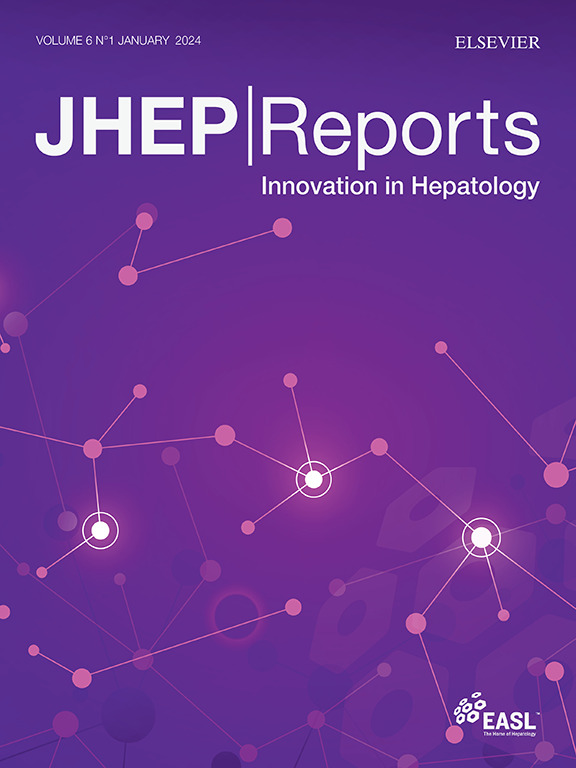Inflammation in liver fibrosis and atrial fibrillation: A prospective population-based proteomic study
IF 7.5
1区 医学
Q1 GASTROENTEROLOGY & HEPATOLOGY
引用次数: 0
Abstract
Background & Aims
Elevated liver stiffness has been associated with atrial fibrillation (AFib) in the general population. The mechanism underlying this association is unclear.
Methods
Participants were recruited from the general population and prospectively enrolled with follow-up for 5 years. The fibrosis-4 (FIB-4) index was used as a surrogate marker for liver fibrosis. Proteomics analysis was performed using the 92-target Olink inflammation panel. Validation was performed using the NAFLD fibrosis score (NFS), aspartate aminotransferase to platelet index (APRI), and repeat confirmation proteomics.
Results
A sample of 11,509 participants with a mean age of 54.0 ± 11.1 years, 51.3% women, and a median FIB-4 index of 0.85 (0.65/1.12), was used. The FIB-4 index was predictive for prevalent (FIB-4 index adjusted odds ratio (aOR) per SD: 1.100 with 95% CI 1.011-1.196; p = 0.026), but not incident AFib (log[FIB-4 index]) adjusted hazard ratio: 1.125 with 95% CI 0.943-1.342, p = 0.19). Elastic net regularized regression identified CCL20, DNER, and CXCL10 for prevalent AFib, and AXIN1, CXCL10, and Flt3L for the log(FIB-4 index) (per SD) as most important in common regulated proteins. The relationship between the FIB-4 index, the identified proteins, and AFib was relevant and reproduced at the 5-year follow-up for CXCL10 after adjusting for confounders (log[FIB-4 index] per SD - CXCL10 [per SD] adjusted β 0.160 with 95% CI 0.127-0.194, p <0.0001; CXCL10 [per SD] - AFib aOR 1.455 with 95% CI 1.217-1.741, p <0.0001), reproduced using the NFS and APRI, and corresponding to increased serum levels.
Conclusions
CXCL10 is linked to liver fibrosis, as determined by the FIB-4 index, and to prevalent AFib.
Impact and implications:
How elevated liver stiffness relates to atrial fibrillation in the general population remains to be clarified. We hypothesized that systemic inflammation against a background of liver fibrosis produced from metabolic dysfunction-associated steatotic liver disease (MASLD), is involved in the pathophysiology of atrial fibrillation. Using large-scale targeted proteomics, we found that CXCL10 is related to both liver fibrosis, as defined by the fibrosis-4 index, and to atrial fibrillation. These results can aid evidence-based drug development for patients with atrial fibrillation and MASLD-related liver fibrosis.

肝纤维化和心房颤动中的炎症:一项基于人群的前瞻性蛋白质组学研究
背景& 目的在普通人群中,肝脏僵硬度升高与心房颤动(AFib)有关。方法从普通人群中招募参与者,进行为期5年的前瞻性随访。肝纤维化-4(FIB-4)指数被用作肝纤维化的替代标志物。蛋白质组学分析采用了92个靶点的Olink炎症面板。使用非酒精性脂肪肝纤维化评分(NFS)、天冬氨酸氨基转移酶与血小板指数(APRI)和重复确认蛋白质组学进行了验证。结果样本中有11509名参与者,平均年龄为54.0±11.1岁,女性占51.3%,FIB-4指数中位数为0.85(0.65/1.12)。FIB-4 指数可预测心房颤动的发病率(FIB-4 指数调整后每 SD 的比值比 (aOR):1.100,95% CI 1.011-1.196;p = 0.026),但不能预测心房颤动的发病率(log[FIB-4 指数])调整后的危险比:1.125,95% CI 0.943-1.342,p = 0.19)。弹性网正则化回归确定了CCL20、DNER和CXCL10对流行性心房颤动的影响,以及AXIN1、CXCL10和Flt3L对log(FIB-4指数)(每标清)的影响,它们是常见调节蛋白中最重要的。在对混杂因素进行调整后,FIB-4指数、已确定的蛋白质和心房颤动之间的关系是相关的,并且在5年随访中,CXCL10的关系再现(log[FIB-4 index] per SD - CXCL10 [per SD] adjusted β 0.160 with 95% CI 0.127-0.194, p <0.0001;CXCL10 [per SD] - AFib aOR 1.455 with 95% CI 1.217-1.结论CXCL10与肝纤维化(由FIB-4指数确定)以及心房颤动的流行有关。影响和意义:肝脏僵硬度升高与普通人群心房颤动的关系仍有待明确。我们假设,在代谢功能障碍相关性脂肪性肝病(MASLD)导致肝纤维化的背景下,全身性炎症参与了心房颤动的病理生理学过程。通过大规模靶向蛋白质组学研究,我们发现 CXCL10 既与肝纤维化(由纤维化-4 指数定义)有关,也与心房颤动有关。这些结果有助于为心房颤动和MASLD相关肝纤维化患者开发循证药物。
本文章由计算机程序翻译,如有差异,请以英文原文为准。
求助全文
约1分钟内获得全文
求助全文
来源期刊

JHEP Reports
GASTROENTEROLOGY & HEPATOLOGY-
CiteScore
12.40
自引率
2.40%
发文量
161
审稿时长
36 days
期刊介绍:
JHEP Reports is an open access journal that is affiliated with the European Association for the Study of the Liver (EASL). It serves as a companion journal to the highly respected Journal of Hepatology.
The primary objective of JHEP Reports is to publish original papers and reviews that contribute to the advancement of knowledge in the field of liver diseases. The journal covers a wide range of topics, including basic, translational, and clinical research. It also focuses on global issues in hepatology, with particular emphasis on areas such as clinical trials, novel diagnostics, precision medicine and therapeutics, cancer research, cellular and molecular studies, artificial intelligence, microbiome research, epidemiology, and cutting-edge technologies.
In summary, JHEP Reports is dedicated to promoting scientific discoveries and innovations in liver diseases through the publication of high-quality research papers and reviews covering various aspects of hepatology.
 求助内容:
求助内容: 应助结果提醒方式:
应助结果提醒方式:


